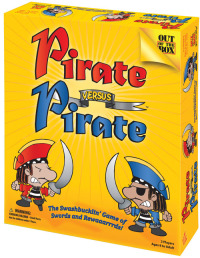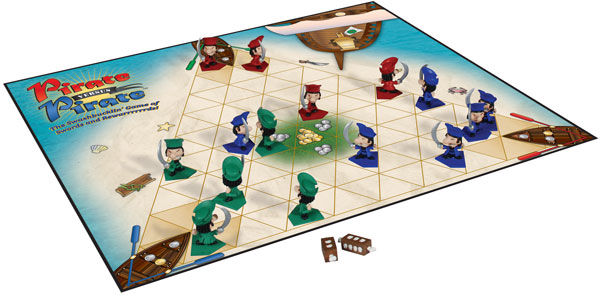A Review of Pirate versus Pirate
 Thursday, January 20, 2011 at 08:25PM
Thursday, January 20, 2011 at 08:25PM Review
Pirate versus Pirate
Out of the Box Publishing
Designed by Max Winter Osterhaus, Ellen Winter, and Al Waller

Linked in name, art design, and cute little sculptures, Pirate versus Pirate is a spiritual sequel to last year’s Ninja versus Ninja. I liked that two-player game, but given that two-players isn’t the way I usually play games, Ninja versus Ninja was pretty quickly moved to the back shelf of the game closet. Pirate versus Pirate is a bit of a rarity as it is designed specifically for three players. Though I’m sure two-player games are more played and more common than three-player games in general, I find myself in three-player games more often than any other number. The problem with that is most games are terrible with three players—at least games that have any kind of conflict. Most commonly, two of the players in a game start picking on one another, and the third player breezes to an easy victory. I’ve also seen a lot of games where two players both pick on the third player and that player has no chance of winning. In either scenario, fun, certainly, has not been had by all. So, when I heard that Pirate versus Pirate was primarily a three-player game (it will play two, though I don’t recommend it), I was both excited and worried. If it handled three players well, it would certainly find some table time in my group. If not, like Ninja versus Ninja, it would likely sit on the shelf gathering dust.
So, how did it turn out? Pretty well.
First, I’ll take a look at the components. As you can see from the picture below, Pirate versus Pirate is a cool-looking game. The pirate sculpts from Dork Tower’s John Kovalic are just awesome. I didn’t really expect him to be able to top the ninjas from Ninja versus Ninja, but the pirates are even cooler looking. I found myself wondering what other games I could use them for so they could be seen by more players. The board is a triangular map board with three silver coins and one gold coin placed in the middle of the board, equidistant from the three starting areas. The coins are attractive, but made of light plastic making them feel pretty insignificant in the hand.

And, it would make sense if they were heavier and more impressive, because the coins are the focus of the game. To win the game, a player must pick up two silver coins or the single gold coin and return it to the appropriate spot on their home base. Moving is accomplished by rolling two four-sided dice (These are cleverly designed four-sided dice, but I think I would rather have the traditional four-sided dice). So, there is the roll-and-move component so common in traditional American board games and so maligned by the designer game community. If you have too much of an allergy to randomness in your board games, look elsewhere. The dice rolls are of upmost importance. If one player rolls way above average and another way below average, the high-roller will win every time regardless of strategy.
Luckily, there are plenty of rolls in the game, so the luck usually balances out. And, you are not always looking for a high roll because of the strict movement rules.
- · A player must move just one pirate a number of spaces equal to the total of the two dice
- · A player may not move through another pirate (the opponent’s or his own)
- · A player may pick up a coin mid-move, but cannot drop off a coin mid move nor deliver a coin mid-move
- · While carrying a coin, a pirate may not move through or onto a spot containing a coin, nor may he attack another pirate
- · A pirate must land on the coin drop-off spot by exact count of his total move
These rules mean rolling high isn’t always the answer (though it will help you keep the action on your corner of the board), and they mean you are often forced to make moves you might otherwise not make in order to not waste a roll.
A turn of the game goes very quickly. The player rolls the dice, totals them, and moves that exact number of spaces. If the player can land on an opposing pirate by exact count, that pirate is removed from the game. If a player moves onto or through a space containing a coin, he picks it up. Then, the next player goes and repeats the process. This continues until one of the players has met the victory conditions. This will involve a lot of jockeying around to get your own pirates out of the way and clear a path to your boat, a process often aided by your opponent’s as they take out figures through attacks.
So, does the game effectively deal with the three-player problems? I think it does to a point. Because everyone must venture out of their area to grab coins, and because those coins are limited, it is impossible to lose focus and ignore someone going for an easy victory. I suppose that another common problem with three-player games is still a problem: often Player B could stop Player A from winning by attacking the figure that is carrying the deciding coin but chooses to focus on his own coin and let Player C deal with it. If this happens and Player C gets no rolls that allow him to reach Player A’s pirate, then the game is handed to Player A. It is a charge that can be leveled at most three-player games and I’ve seen it happen with P vs P. That said, the game is light and fast, so I don’t need it to be perfectly balanced, just fun and not obscenely imbalanced, and P vs. P is good on that front.
For a roll and move game, it ends up being pretty clever and interesting. As long as none of the players spends too much time analyzing their board position and attempting to make the perfect move, the game is light and fast-playing. It works as a kid’s game. It works as filler on game nights. Given its price and the awesome components, I have no problem recommending the game for families and for gamers looking for a unique, three-player filler.
 Dork Tower,
Dork Tower,  John Kovalic,
John Kovalic,  Ninjas,
Ninjas,  Pirates,
Pirates,  reviews in
reviews in  Board Games
Board Games 